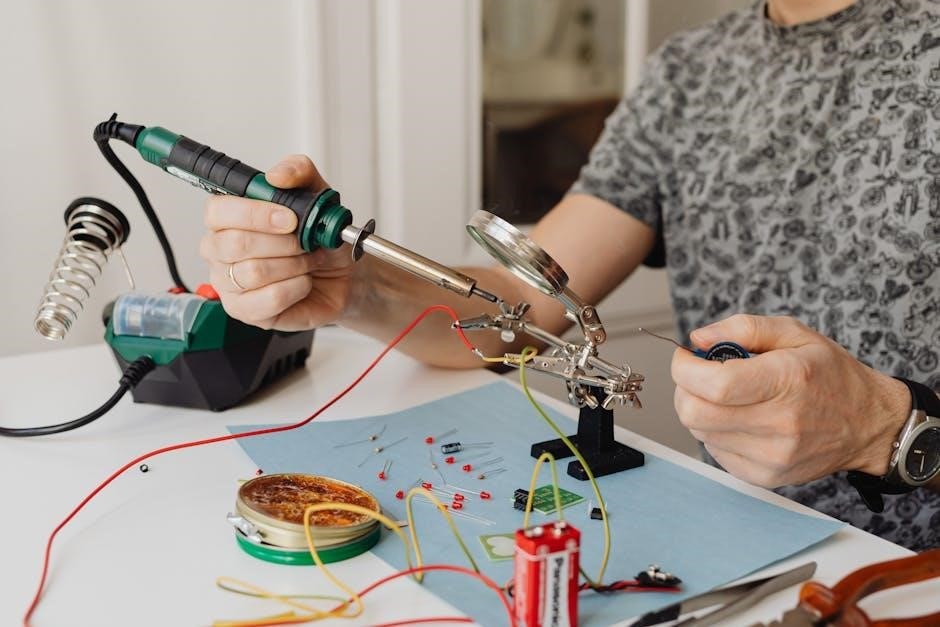Welcome to the AstroAI Multimeter Manual, your comprehensive guide to understanding and using AstroAI’s digital multimeters safely and effectively. This manual covers essential safety, operation, and maintenance tips.
1.1 Overview of AstroAI Brand and Products
AstroAI is a trusted brand specializing in automotive and household tools, offering high-quality products like air compressors, tire inflators, and digital multimeters. Known for innovation and reliability, AstroAI multimeters are popular for their advanced features, including voltage, current, and resistance measurement. The brand caters to global markets, providing user-friendly solutions for professionals and DIY enthusiasts. AstroAI products are designed to meet diverse needs, ensuring safety and precision. Their digital multimeters, such as the ASIMT33D and WH5000A models, are widely recognized for their accuracy and durability. With a focus on customer satisfaction, AstroAI continues to expand its product line, delivering efficient tools for everyday use.
1.2 Importance of the AstroAI Multimeter Manual
The AstroAI Multimeter Manual is an essential resource for users to ensure safe and effective operation of their device. It provides detailed safety guidelines, operational instructions, and technical specifications, helping users understand their multimeter’s capabilities and limitations. The manual is crucial for beginners to avoid potential hazards and for experienced users to optimize their measurements. It also covers maintenance tips to prolong the multimeter’s lifespan. By following the manual, users can unlock the full potential of their AstroAI multimeter while minimizing risks. This guide is indispensable for anyone aiming to use their device accurately and responsibly. Refer to it regularly for optimal performance and safety.
Safety Information and Precautions
This section outlines critical safety guidelines for using the AstroAI multimeter. It emphasizes proper handling to prevent electric shock, damage, and ensures accurate measurements. Always follow precautions.
2.1 General Safety Guidelines
To ensure safe and accurate use of the AstroAI multimeter, always read the manual thoroughly before operation. Avoid electric shock by never touching electrical conductors with wet hands or while standing on conductive surfaces. Use the multimeter only for its intended purposes, as specified in this manual. Ensure all connections are correct to prevent damage to the device or injury. Never move the rotary switch during measurements, as this could cause internal damage. Keep the multimeter away from hazardous environments, such as areas with flammable gases or extreme temperatures. Regularly inspect the device for damage and adhere to all safety precautions outlined in this guide.
2.2 Warning Labels and Symbols
The AstroAI multimeter features various warning labels and symbols to ensure safe operation. These include the “High Voltage” symbol, indicating potentially dangerous voltages, and the “Prohibited” symbol, signaling actions to avoid. The “Caution” symbol warns of potential hazards, while the “Battery” symbol alerts users to proper battery handling. All labels are designed to prevent accidents and protect both the user and the device. Familiarize yourself with these symbols before use, as they provide critical safety information. Always follow the instructions and precautions indicated by these labels to ensure safe and accurate measurements. Failure to comply may result in injury or device damage.
2.3 Proper Handling and Storage
To ensure the longevity and accuracy of your AstroAI multimeter, proper handling and storage are essential. Avoid exposing the device to extreme temperatures, humidity, or direct sunlight, as these can damage internal components. Always handle the multimeter with clean, dry hands to prevent contamination. When not in use, store it in a protective case to shield it from physical damage. Clean the multimeter with a soft, dry cloth, avoiding harsh chemicals. Replace the battery correctly and store it in a cool, dry place. Proper care ensures reliable performance and extends the life of your AstroAI multimeter. Follow these guidelines carefully.
This section helps you familiarize yourself with the AstroAI multimeter’s features, components, and functionality. Learn about its key features, components, and how to use the display and buttons effectively. The AstroAI multimeter stands out for its advanced features, including TRMS technology for accurate measurements, a 6000-count display, and auto-ranging capabilities for convenience. It supports voltage, current, resistance, continuity, and diode testing, along with temperature and frequency measurements. Designed with safety in mind, it is CAT III 1000V rated, protecting users from high-voltage hazards. The device is user-friendly, featuring a clear LCD display and intuitive buttons. Its compact design and durable construction make it ideal for both professionals and DIY enthusiasts. Regular updates and comprehensive support ensure it remains a reliable tool for various applications. The AstroAI multimeter is equipped with a range of essential components designed for precise and efficient measurements. The primary parts include the LCD display, which shows readings clearly, and the rotary switch for selecting measurement modes such as voltage, current, and resistance. The device features intuitive buttons for functions like hold, range selection, and mode toggling. Input terminals are provided for connecting test leads, while the probes themselves are durable and reliable for various applications. Additionally, the multimeter includes a battery compartment for power and may have optional features like temperature sensors or LED indicators for continuity testing. These components ensure accurate and user-friendly operation. The AstroAI multimeter features a clear LCD display that shows measurements, modes, and additional indicators. The display includes a backlight for better visibility in low-light conditions. Key buttons include the power button for turning the device on/off, a hold button to freeze measurements, and a range button for manual mode adjustments. The mode button toggles between voltage, current, resistance, and other functions. The display also shows indicators like auto-ranging, battery status, and warning symbols for overload protection. These intuitive controls and visual cues ensure precise and convenient operation, making it easy to navigate and perform various measurement tasks efficiently. Learn how to power on/off, select modes, and use the rotary switch for precise measurements. Follow step-by-step guides for voltage, current, and resistance testing safely and efficiently. To turn on the AstroAI multimeter, press and hold the power button located on the front panel until the display lights up. The multimeter is equipped with a low-power indicator; when the battery is low, the display will show a blinking symbol. For models with an auto-power off feature, the device will automatically shut down after 15 minutes of inactivity to conserve battery life. To turn it off manually, press and hold the same power button until the display turns off. Always ensure the multimeter is powered off when not in use to prolong battery life. Use a 9V battery for replacement. To ensure accurate measurements, select the correct mode using the rotary switch. For voltage (V), current (A), or resistance (Ω), align the switch with the desired symbol. The multimeter also features continuity and diode testing modes. Advanced models include frequency and temperature measurement options. Always confirm the mode matches your task to avoid errors. Use the button to toggle between DC and AC measurements when applicable. Refer to the display for mode confirmation and range selection. Proper mode selection is crucial for precise readings and instrument safety. Misalignment can lead to inaccurate results or damage. Always double-check the selected mode before starting measurements. The rotary switch is a central control for selecting measurement modes and ranges. Rotate it to align the indicator with the desired function: voltage (V), current (A), resistance (Ω), or continuity/diode testing. Advanced models may include frequency and temperature modes. Always set the switch to the correct mode before starting measurements. Avoid moving the switch during measurement to prevent damage. For voltage and current, ensure the switch is set to DC or AC, depending on the source. The multimeter’s display will confirm the selected mode. Proper use of the rotary switch ensures accurate readings and protects the device from potential overload; Follow manual guidelines for optimal performance. To perform accurate measurements, ensure the multimeter is set to the correct mode using the rotary switch. For voltage and current, select DC or AC based on the source. Connect the black probe to the COM port and the red probe to the appropriate voltage or current terminal. For resistance, ensure the circuit is powered off. Gently touch the probes to the test points. The display will show the reading. Avoid touching metal parts of the probes to prevent erroneous results. After measurement, disconnect the probes and store them safely. Always refer to the manual for specific mode settings and safety guidelines to ensure precise and damage-free operation. Explore the versatile measurement modes of the AstroAI multimeter, including voltage, current, resistance, continuity, and diode testing. Advanced functions like frequency and temperature add versatility to your measurements. The AstroAI multimeter allows precise measurement of both DC and AC voltage, essential for diagnosing electrical systems. Use the rotary switch to select the appropriate voltage range. For DC voltage, choose the DCV mode, and for AC, select ACV. Ensure the multimeter is set to the correct function before connecting the probes to avoid damage. Connect the black probe to the COM port and the red probe to the VΩmA port. The digital display will show the voltage reading, helping you identify issues in circuits, batteries, or power supplies. Always refer to safety guidelines to prevent electric shock or device damage. The AstroAI multimeter enables accurate measurement of both DC and AC current, crucial for analyzing electrical circuits. For DC current, select the DCA mode, and for AC, choose ACA mode. Use the 10A or 10mA port based on the expected current level. Always ensure the multimeter is set to the correct range before connecting probes to avoid damage. Connect the black probe to COM and the red probe to the appropriate current port. The display will show the current reading, helping you assess power consumption or identify circuit faults. Be cautious not to exceed the multimeter’s current range to prevent damage or electric shock. The AstroAI multimeter allows you to measure resistance in electrical components, essential for diagnosing circuits and ensuring proper connectivity. Select the resistance mode (often marked with the Ω symbol) and choose the appropriate range for the component being tested. Connect the black probe to the COM port and the red probe to the VΩmA port. Ensure the component is disconnected from any power source to avoid inaccurate readings. The multimeter will display the resistance value in ohms. This feature is crucial for identifying open circuits, short circuits, or faulty components. Always discharge capacitors before measuring resistance to prevent electric shock or damage to the device. The AstroAI multimeter includes a continuity test feature, which emits a beep when it detects a complete circuit with low resistance. This is useful for identifying faulty wires or connections. To use this feature, select the continuity mode (often marked with a diode symbol) and connect the probes to the circuit. For diode testing, the multimeter can check the forward and reverse bias of diodes, helping identify faulty components. Ensure the component is isolated from the circuit and properly connected to the probes. The multimeter will display the voltage drop across the diode. This function is essential for troubleshooting electrical circuits and components safely and efficiently. Always refer to the manual for specific instructions to avoid errors. The AstroAI multimeter offers advanced functions for measuring frequency and temperature, enhancing its versatility in various applications. To measure frequency, ensure the multimeter is in the correct mode and connect the probes to the signal source. The device will display the frequency in Hz, covering a range from 1Hz to 100kHz. For temperature measurement, use the included thermocouple probe to measure temperatures between -40°C and 1000°C. This feature is ideal for HVAC and automotive diagnostics. Always ensure the multimeter is set to the appropriate function to avoid inaccuracies. Refer to the manual for specific instructions on using these advanced features safely and effectively. The AstroAI multimeter features high accuracy, measuring voltage, current, resistance, continuity, frequency, and temperature. It offers a clear LCD display, long battery life, and durable design. The AstroAI multimeter offers precise measurements with a range of 0-600V for DC/AC voltage, 0-10A for DC/AC current, and 0-60MOhm for resistance. It ensures high accuracy for continuity, diode testing, and frequency up to 1MHz. The multimeter also measures temperature with a range of -20°C to 1000°C, using K-type thermocouples. Designed for reliability, it meets CAT III 1000V safety standards, protecting against overvoltage. With automatic ranging and manual mode options, it caters to both beginners and professionals. The device ensures reliable performance across various automotive and household applications, making it a versatile tool for accurate diagnostics and troubleshooting. The AstroAI multimeter features a high-resolution 6000-count LCD display, ensuring precise and clear readings for all measurements; With a fast update rate of up to 3 times per second, the device provides smooth and real-time monitoring of voltage, current, resistance, and other parameters. This makes it ideal for dynamic measurements and troubleshooting. The display also includes a backlit function for improved visibility in low-light conditions. The combination of high resolution and rapid updates ensures accurate and responsive performance, making it suitable for both professional and DIY applications. This feature enhances the overall user experience and reliability of the multimeter. The AstroAI multimeter operates on 1.5V/9V/12V batteries, ensuring versatile power options. It features an automatic power-off function to preserve battery life, along with a low battery indicator for timely replacements. With efficient power management, the device can operate for up to 200 hours on a single set of batteries. For optimal performance, it is recommended to use high-quality batteries. This design ensures extended usage and minimizes downtime, making it suitable for both professional and DIY applications. The battery compartment is easily accessible, allowing quick replacements when needed, thus enhancing user convenience and overall efficiency. Regularly clean the multimeter with a soft cloth and avoid exposure to moisture. Check battery connections and ensure proper installation. Address common issues like faulty readings by recalibrating or replacing fuses. Regular cleaning ensures accurate measurements and prolongs the multimeter’s lifespan. Use a soft, dry cloth to wipe the exterior and remove any dirt or debris. Avoid using liquids or harsh chemicals, as they may damage the device. For the probes, gently clean the tips with a cotton swab or soft brush to maintain conductivity. Ensure all ports and connectors are free from dust or residue. If using a damp cloth, ensure it is minimally moist and avoid direct contact with internal components. Proper cleaning prevents corrosion and ensures reliable performance. Store the multimeter in a dry, cool place to maintain its condition and functionality. To replace the battery in your AstroAI multimeter, first ensure the device is turned off to avoid any accidental power drain or measurement errors. Locate the battery compartment, typically found on the rear or side of the multimeter. Open it by sliding or unscrewing the cover, depending on the model. Remove the old battery and insert the new one, ensuring the polarity matches the diagram inside the compartment. Close the cover securely and turn the multimeter on to test its functionality. Use only the recommended battery type to maintain performance and avoid damage. Refer to the manual for specific instructions tailored to your model. If your AstroAI multimeter experiences inaccurate measurements, first check the battery for low power or improper installation. Ensure all connections are clean and secure. For display malfunctions, restart the device or replace the battery. If the multimeter fails to power on, verify the battery is correctly installed and not drained. For persistent issues, consult the troubleshooting section in the manual. Avoid using damaged test leads, as they can cause faulty readings. Regularly clean the multimeter’s exterior and internal components to maintain optimal performance. Refer to the user manual for detailed solutions tailored to your specific model and issue. Proper maintenance ensures accurate and reliable results. Explore PDF manuals, customer support, and warranty details for your AstroAI multimeter. Visit the official website for tutorials, guides, and troubleshooting tips to enhance your experience. To access the AstroAI multimeter manual, visit the official website or authorized retailers. The PDF manual is available in multiple languages, including English, German, French, Spanish, and Japanese. Ensure you download the correct version for your specific model, such as the ASIMT33D or WH5000A. The manual provides detailed safety guidelines, operational instructions, and technical specifications. It also includes troubleshooting tips and maintenance advice. Downloading the PDF ensures you have a comprehensive guide always available for reference. This resource is essential for optimizing your multimeter’s performance and ensuring safe usage. Regularly check for updates to stay informed about new features or improvements. AstroAI provides dedicated customer support to assist with any questions or issues regarding your multimeter. For inquiries, visit their official website or contact their support team via email, phone, or live chat. The warranty period for AstroAI multimeters typically covers manufacturing defects for up to 3 years. Extended warranty options may be available for purchase. For repairs or replacements, contact their customer service or visit authorized service centers. AstroAI also offers online resources, including FAQs and troubleshooting guides, to help resolve common issues. Their commitment to customer satisfaction ensures reliable assistance throughout the product’s lifespan. AstroAI provides an array of online tutorials and guides to help users master their multimeters. These resources are available on platforms like YouTube and the official AstroAI website. They cover basic operations, advanced functions, and troubleshooting tips, ensuring users can make the most of their devices. For instance, the AstroAI ASIMT33D Digital Multimeter has dedicated tutorials that walk users through measuring voltage, current, and resistance with precision. Additionally, forums and community discussions offer peer-to-peer support, where users share their experiences and solutions to common problems. By utilizing these resources, users can enhance their understanding and improve their efficiency when working with the multimeter, ensuring optimal performance and safety. The AstroAI Multimeter Manual has provided a detailed guide to safely and effectively using your digital multimeter. By following the safety precautions, understanding the device’s features, and mastering its functions, you can confidently perform various measurements. Regular maintenance and troubleshooting tips ensure longevity and optimal performance. For further assistance, AstroAI offers online resources, tutorials, and customer support. This manual serves as a comprehensive reference, empowering you to make the most of your multimeter. Remember to always prioritize safety and adhere to the guidelines outlined in this manual for accurate and reliable results. Happy measuring with AstroAI!
Understanding Your AstroAI Multimeter
3.1 Key Features of the AstroAI Multimeter

3.2 Components and Parts Overview
3.3 Display and Button Functions

Operating the AstroAI Multimeter
4.1 Turning the Multimeter On/Off
4.2 Selecting the Correct Measurement Mode
4.3 Using the Rotary Switch
4.4 Basic Measurement Procedures
Measurement Modes and Functions
5.1 Voltage Measurement (DC/AC)
5.2 Current Measurement (DC/AC)

5.3 Resistance Measurement
5.4 Continuity and Diode Testing

5.5 Advanced Functions (Frequency, Temperature)

Technical Specifications
6.1 Range and Accuracy
6.2 Display Resolution and Update Rate
6.3 Power Requirements and Battery Life

Maintenance and Troubleshooting
7.1 Cleaning the Multimeter
7.2 Replacing the Battery
7.3 Common Issues and Solutions

Additional Resources
8.1 Downloading the PDF Manual
8.2 Customer Support and Warranty Information
8.3 Online Tutorials and Guides






